Sunday, 30 June, Strasbourg and wine tasting, with complicated logistics and real wildlife
Written 22 August 2019
We left Speyer at dinner time on Saturday and arrived at Strasbourg during breakfast on Sunday.
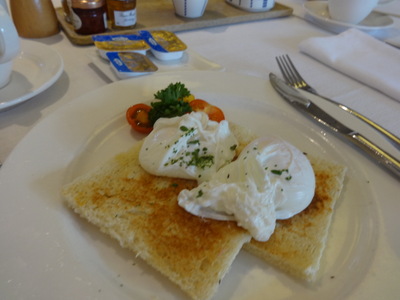
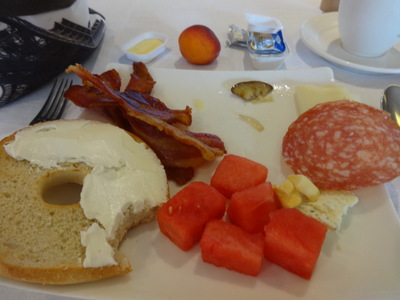 The previous day's poached egg had been so good that I ordered them again and ate both. Along with some other stuff, as shown at the right: watermelon, several cheeses, salami, bacon, grilled eggplant, and half a bagel. The apricot wasn't ripe, so I took it back to my stateroom to soften up.
The previous day's poached egg had been so good that I ordered them again and ate both. Along with some other stuff, as shown at the right: watermelon, several cheeses, salami, bacon, grilled eggplant, and half a bagel. The apricot wasn't ripe, so I took it back to my stateroom to soften up.
The Rhine forms the border between France and Germany, and Strasbourg lies along it on the French side, directly opposite Kehl, which lies along it on the German side. The port of Strasbourg is actually within its city limits because it branches off via the Canal of the Rhine into French territory to form several finger-shaped basins, in one of which we tied up.
At 8:30 a.m., Quietvoxes in hand, we boarded our designated bus for our city tour. On the way, our guide told us that Strasbourg is France's 7th largest city, having a population 150,000 in the city itself and half a million in greater Strasbourg. The city was founded by the romans in 12 BC as a military camp called "Argentoratum." It later expanded into a merchant city.
The present name, "Strasbourg," means "city at the crossroads." It is the second largest river port in France (after Paris) and the second largest on the on the Rhine (after some place in Germany). Local wine production sis about about 90% white and 10% red, mostly dry. It also produces about 70% of France's beer, in its suburbs, where Heineken and others have their headquarters. It is the second largest diplomatic city outside of Paris.

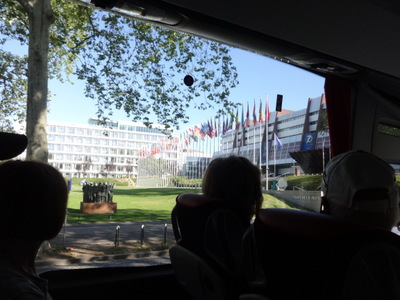 We took the scenic route into town, past, among other things the lovely new Russian Orthodox church, consecrated only a month ago. So many Russians and others of Russian Orthodox faith are living in Strasbourg, because of EU business, that renting space for services was no longer an option.
We took the scenic route into town, past, among other things the lovely new Russian Orthodox church, consecrated only a month ago. So many Russians and others of Russian Orthodox faith are living in Strasbourg, because of EU business, that renting space for services was no longer an option.
Our route looped through the northern part of the city, which has become more or less an EU campus because so many EU institutions are headquartered there (11 in all). At the right here is (I think) the European Court of Justice.
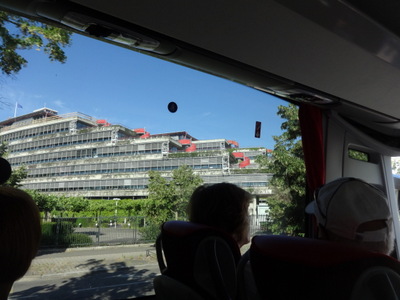
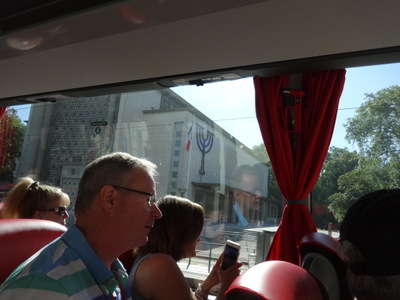 At the left here is (I think) the other side of the Court of Justice, although we drove around among many imposing glass and steel buildings with rows of flags out front (the court, the EU Parliament, the Council of Europe, parts of the university), so it was hard to keep track of which buildings I was getting photos of. One of the buildings (Council of Europe, maybe) was described as fortress-like on the outside but soft and comfy inside, to show that Europe is strong against enemies but cushy inside.
At the left here is (I think) the other side of the Court of Justice, although we drove around among many imposing glass and steel buildings with rows of flags out front (the court, the EU Parliament, the Council of Europe, parts of the university), so it was hard to keep track of which buildings I was getting photos of. One of the buildings (Council of Europe, maybe) was described as fortress-like on the outside but soft and comfy inside, to show that Europe is strong against enemies but cushy inside.
You have to exhaust all legal recourse in your own country before you come to the European court with complaints about your country. The court includes 11 judges, one for each country, and each is paid a salary equal to the high salary paid to any judge in Europe. (This last is supposed to prevent corruption, though I don't really see what's to prevent any particular judge from wanting more than the highest salary paid to any judge in Europe.)
At the right is a rather poor shot (through the window of a moving bus past fellow passengers) of the city's Grande Synagogue de la Paix (Grand Synagogue of Peace). On its side is a menorah with only six branches, in memory of the six million who died in the holocaust. It was built in the 1950's to replace the one that was pillaged and burned down by the Nazi's during WWII. It's the largest in France and even has its own local radio station.
We also saw the Orangerie Park (the largest in Strasbourg; supposedly based on plans from André Lenôtre), which includes a zoo and museums. It was once the house and grounds of Napoleon's wife Josephine; the guide said no orange trees are left there now.
We even drove by (just as we left the port) the national headquarters of the French Foreign Legion, which is still in existence and going strong. It was created in 1830, and you can still (as always) join under any name you choose, no questions asked, and when discharged, you're eligible for French citizenship.
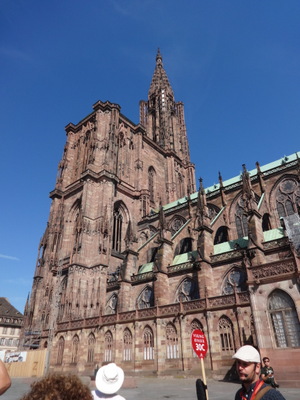
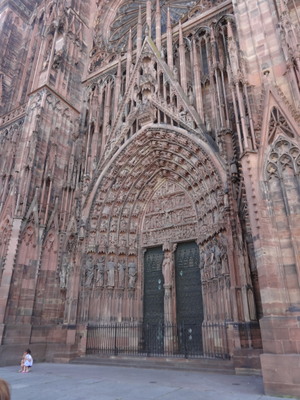 At the end of our scenic bus tour, we were dropped off near the cathedral. Walking toward it, we passed through one little street of shops that was practically lined with simple wooden planters—essentially roughsawn wooden rectangles, maybe a foot square in cross section and 1–2 feet long, that people had stacked in a variety of configurations, filled with dirt, and planted stuff in. Nice.
At the end of our scenic bus tour, we were dropped off near the cathedral. Walking toward it, we passed through one little street of shops that was practically lined with simple wooden planters—essentially roughsawn wooden rectangles, maybe a foot square in cross section and 1–2 feet long, that people had stacked in a variety of configurations, filled with dirt, and planted stuff in. Nice.
The cathedral is built of a dark rose-colored sandstone, and I can show only fragmentary views of it. It's particularly hard to photograph all of because there's so little space left around it. It has no parvis because other buildings come right up to within a few feet of it, and you can't get far enough away to fit much of it into the frame.
Our walking tour didn't involve going inside, but David and I have seen it before (we were in Strasbourg for a week in 1995; they do a terrific 14 July parade and fireworks display!). If you ever get the chance to go, it's worth a visit to the cathedral just to see its spectacular astronomical clock!
The cathedral is at the highest point in the city and is itself 142 m high; at one point in the 19th century, it was the tallest church in the Christian world. (The pyramids were higher, but they weren't in the Christian world.) It was begun in 1015. Most of the stained glass is original, from the 13th and 14th centuries. Some of the windows were among the items brought back by the Monuments Men after WWII.
Near the cathedral, the guide showed us a small stone column on a street corner. To qualify to work on the cathedral during its construction, you had to prove that you could squeeze through between it and the wall behind it. That showed you could squeeze through the spaces you needed to work on the cathedral.
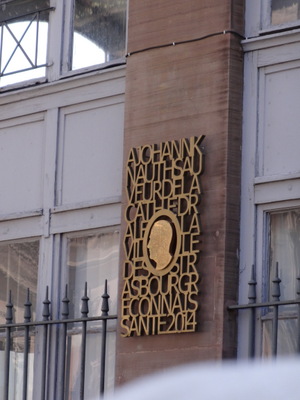
 Near the spot where the guide stood to show us the cathedral, on the wall of a nearby museum, is the plaque shown here at the left. The writing, in all caps, has no spaces between the words, no punctuation, and no accents, and the words wrap to the next line any old where, without hyphens, so it took me a minute to puzzle it out, but it says, "A Johann Knauth sauveur de la cathédrale la Ville de Strasbourg reconnaissante 2014"—"to Johann Knauth savior of the cathedral the grateful city of Strasbourg 2014."
Near the spot where the guide stood to show us the cathedral, on the wall of a nearby museum, is the plaque shown here at the left. The writing, in all caps, has no spaces between the words, no punctuation, and no accents, and the words wrap to the next line any old where, without hyphens, so it took me a minute to puzzle it out, but it says, "A Johann Knauth sauveur de la cathédrale la Ville de Strasbourg reconnaissante 2014"—"to Johann Knauth savior of the cathedral the grateful city of Strasbourg 2014."
When I asked what Mr. Knauth did to save the cathedral, the guide explained that, after the revolution, people's first inclination was to tear down or deface all religious institutions, but Johann came up with a way to stop them. He suggested that the cathedral should wear a gargantuan red Phrygian cap, to show its sympathy with the revolution; all good revolutionaries wore them. So a huge cap was constructed—it had an opening that fit down over the spire—and the cathedral wore it for many years. The cap was removed about the turn of the 19th century and put in storage, where it was accidentally destroyed during the Franco Prussian war. (That was in 1870–71, the war in which France lost Alsace to Prussia/Germany. It stayed German until WWI.)
Next stop on the tour was the Place Gutenberg, which is still graced by the double-decker antique carousel we saw there in 1995. Most French cities now have antique carousels, though most are not double-decker. I suspect they're not really antiques, but modern reproductions. I got to ride a real antique one at the Musée des Arts Forain during our visit to Paris last year.
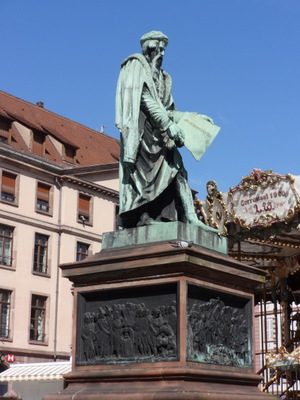
 At the left here is a better view of the 1830 statue of Gutenberg you can see near the carousel (by our old friend David d'Angers). He lived in Strasbourg for 10 years at one point and first experimented with moveable type there, so the city feels entitled to claim him partially.
At the left here is a better view of the 1830 statue of Gutenberg you can see near the carousel (by our old friend David d'Angers). He lived in Strasbourg for 10 years at one point and first experimented with moveable type there, so the city feels entitled to claim him partially.
On the four sides of the statues pedestal are scenes depicting the four continents and the events and progress made possible there by Gutenberg's innovation (I assume that Australia, Antarctica were the ones left out, as having no events or progress at the time the statue was erected). The one facing the us (shown at the right) is the one representing the Americas (which were lumped together for the purpose). It shows Ben Franklin and a number of other signers of the Declaration of Independence, with General Lafayette and Simon Bolivar looking on. In the lower right corner are a family of American Indians and what might be an African slave.
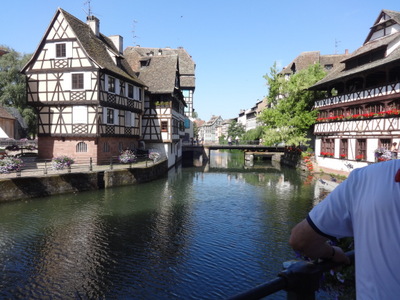
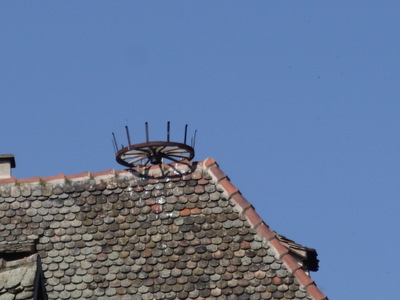 The view at the left is of a particularly quaint little section of town called "La Petite France" ("Little France"). The river Ill, which flows through town, splits at this point, so that the houses at the left in the photo are actually on a island in mid stream. I'd always wondered why "Little France"; aren't quaint sections dense with canals usually called "Little Venice"? The guide explained that it used to be the location of a hospital (now defunct) for syphilis patients. Strasbourg was in Germany at the time, and the Germans called syphilis "the French disease," because they regarded it as having been introduced into the region by French troops. (Of course, at that period, the French called it "the Italian disease," because they thought it had been introduced into France in the 16th century, when France was at war with Italy.
The view at the left is of a particularly quaint little section of town called "La Petite France" ("Little France"). The river Ill, which flows through town, splits at this point, so that the houses at the left in the photo are actually on a island in mid stream. I'd always wondered why "Little France"; aren't quaint sections dense with canals usually called "Little Venice"? The guide explained that it used to be the location of a hospital (now defunct) for syphilis patients. Strasbourg was in Germany at the time, and the Germans called syphilis "the French disease," because they regarded it as having been introduced into the region by French troops. (Of course, at that period, the French called it "the Italian disease," because they thought it had been introduced into France in the 16th century, when France was at war with Italy.
The building at the right-hand edge of the photo is La Maison des Tanneurs (The House of the Tanners); tanners used to occupy the banks of the Ill because they needed so much water. It's now a restaurant. We ate there in 1995, on the balcony overlooking the river, and it's still in operation today.
Basements are very wet in the area, because of the high water table, so the houses all had attics with many small gables, with uncovered windows for air circulation so that things could be stored in the roof. Tanners, in particular, dried hides in the attics for about 30 days. The little openings don't show up in this photo, but the Maison des Tanneurs and many other nearby buildings had them. You can see some on the roofs in the photo of the carousel, above.
At the right is a frame erected on a roof by a householder hoping to attract storks. The storks were in town, and we caught a few glimpses of them, but I didn't manage to get a photo. Having a nest on your roof or chimney is supposed to be lucky, but this householder was having no luck.
The stork is the emblem of Strasbourg; they mate for life and faithfully return to the same nest every year (from their annual migration to Africa). Unfortunately, they were almost lost to habitat change, but they're coming back now after resetoration and reintroduction; not as many as at the beginning of the 20th century, but they'll keep trying.
They say that, if you want a child, you should put a sugar cube out on your balcony for the stork, and it will bring you a baby; if you put out two sugar cubes, you could get twins.
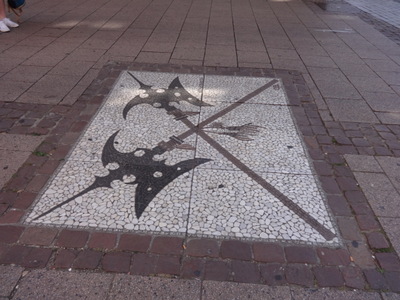
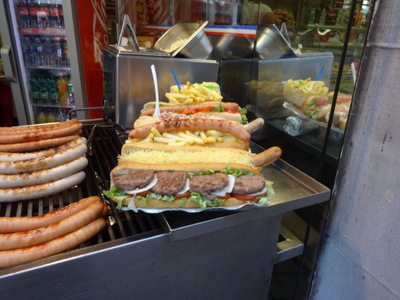 During the tour, we passed a building with this wonderful mosaic sidewalk out front. It didn't seem to match the building's current use, but it must have meant something originally.
During the tour, we passed a building with this wonderful mosaic sidewalk out front. It didn't seem to match the building's current use, but it must have meant something originally.
In a nearby window were these long skinny sausages and hair-raising sandwiches. I think the one in the foreground, with the four hamburger patties, is called an "Américaine." At least it didn't also have French fries in it, like some I've seen.
Other things we learned on the walking tour:
Strasbourg was a free imperial city (i.e., one of those who didn't answer to the archbishop) until 1681, when Louis XIV captured it and made it French for the first time. It had become free by rebelling militarily against the bishop in 1262 (in the 30-years war). (Louis surprised everyone by joining the protestant Swedes againmst the Hapsbourgs)
The most widely spoken non-French dialect in France is Alsatian, which is not mutually intelligible with French.
The city library is the second largest in France, after the one in Paris. Strasbourg has about 60,000 university students. You can get a master's degree for the relatively low cost of about 500 euros/year.
Among other churches in the city, we were shown one that served as the garrison church for the protestant soldiers in Strasbourg. Another was St. Thomas, remarkable because it's very wide inside, and the whole ceiling inside is at the same level—the side aisles are not lower. Albert Schweitzer used to give organ concerts. He was a protestant minister, but that church was not his, which was elsewhere in the city.
The Germans did a lot of building while the city was under their control, so there's a lot of 19th century German architecture to be seen. One example we were shown was a school. In Germany, school was free and compulsory, but that wasn't the case in Strasbourg before, so when the Germans took over. The Germans built a large school behind St. Thomas and required that everybody attend. It was the first school in Strasbourg to have toilets, showers, and a gym.
I think it was the Germans who broke down the city's fortification wall; it had been built not to protect the city from its surroundings but France from the Germans. A metal strip in the pavement now marks the position of the old rampart. People with French-sounding names actually had to change them to the German version. Poeple born at certain times in Strasbourg might have to change their citizenship four or five time during their lifetimes, without ever moving.
The tramway dating from the end the 19th century was taken out in the 1960's, because everyone everywhere back then thought the future of urban transportation was the individually owned automobile. Now we know better, and Strasbourg, like many cities, reinstalled its tram system in the 1980's. Today, you can take the city tram all the way to Kehl, in Germany.
The reformation was first preached in Strasbourg not by Luther himself but by others who took up his ideas. The whole city because protestant in 1516, but when (?) the whole city became protestant, but when the french took it over for the first time, they changed half the churches back to catholic.
Eventually, the walking tour looped back to the cathedral, where our Viking tour escort was waiting to take us back to the buses, which took us back to the ship for lunch.

 For lunch, I started with the salad and pasta bar. On the salad bar I found slices of bread spread with herbed white cheese and topped with slices of cold beef and crispy onions (very good), a sort of Waldorf of slivered apple and raisins, and a strange "wurstsalat" that I didn't think was very good (picture cold hot dogs cut up and tossed with a creamy salad dressing). The pasta of the day was white clam, complete with whole clams in the shell. At the top left, you can see David's plate—he had the pressed Cuban sandwich with fries.
For lunch, I started with the salad and pasta bar. On the salad bar I found slices of bread spread with herbed white cheese and topped with slices of cold beef and crispy onions (very good), a sort of Waldorf of slivered apple and raisins, and a strange "wurstsalat" that I didn't think was very good (picture cold hot dogs cut up and tossed with a creamy salad dressing). The pasta of the day was white clam, complete with whole clams in the shell. At the top left, you can see David's plate—he had the pressed Cuban sandwich with fries.
Then I had the fish and chips. The fried fish started out more or less crisp, but the chef them plopped it on top of a mount of mashed sweet green peas (his interpretation of the "mushy peas" traditional with fish and chips), which sogged the underside badly. The malt vinegar in the little glass was good, but I didn't think much of the tartar sauce. Strangely, it was very hard to convince others at the table that the mashed peas were not guacamole. I assured them that, since I had just eaten it, if it were guacamole, I would be doubled over with stomach pains by now. None of them had ever heard of "mushy peas."
The logistics for the afternoon were complicated, but they were laid out in detail in the Viking Daily. At 1:45 p.m., one bus (with us on it) would set out on a scenic drive through the Alsatian wine country culminating in a wine tasting.
Also at 1:45 p.m., a different bus would take passengers back to Strasbourg who wanted to spend the afternoon there.
At 2 p.m., the ship would cast off and cruise away toward Switzerland.
At 4:40 p.m., the passengers still in Strasbourg (both those who took the 1:45 p.m. bus and those who had stayed on after the morning's tour) would meet their Viking tour escort at the post office beside the cathedral, who would guide them back to the bus that would take them back to the ship. A little later, we would conclude our wine tasting, board our bus, and head for the ship.
At 6 p.m., both buses and the ship would converge on the little village of Schönau, where the ship would dock long enough for both busloads to reembark before continuing toward Basel.
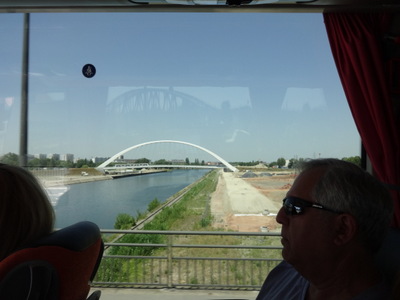
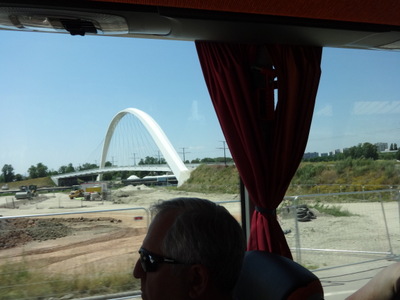 On the way out of town for our tour and wine tasting, we passed this cool bridge. As we first approached, it looked like a typical sort of suspension bridge, supported by an arch. As we passed, though, I could see that it was way cooler than that! The arch was set at an angle to the bridge, so both span the water, but not along the same line. Nice!
On the way out of town for our tour and wine tasting, we passed this cool bridge. As we first approached, it looked like a typical sort of suspension bridge, supported by an arch. As we passed, though, I could see that it was way cooler than that! The arch was set at an angle to the bridge, so both span the water, but not along the same line. Nice!

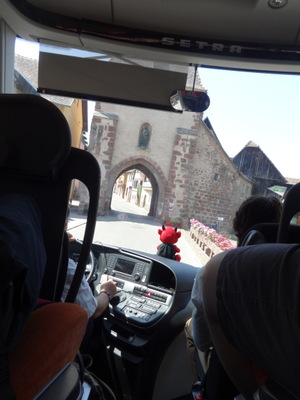 Our destination was the village of Mittlebergheim, which was recently voted the second-most-beautiful village in France (after a place in Normandy, or maybe it was Burgundy). On the way we passed through a number of other villages of differing degrees of picturesquitude.
Our destination was the village of Mittlebergheim, which was recently voted the second-most-beautiful village in France (after a place in Normandy, or maybe it was Burgundy). On the way we passed through a number of other villages of differing degrees of picturesquitude.
In the dark ages, the bad old days of brigands, robber barons, and marauding armies, all the villages had their own walls, and what typically remains standing today is the main gate. As a result, the driver of our bus—one of those big interstate models with luggage compartments underneath, on-board bathrooms, refrigerators for bottled water, and side mirrors the size of surfboards—had to squeeze it through several of these stone archways, which he did with skill and aplomb, never touching the sides, though he had barely inches to spare both left and right.
The little red devil on the dashboard was our driver's personal mascot. Viking drivers wear the red Viking-logo shirts, but for this trip we had one from a charter company whose drivers all wore long-sleeved white button-down shirts and light-colored straw Panama hats.
Among the villages we passed through were Gertwiller (famous for its two rival "pain d'épices"—French gingerbread—companies), Goxwiller (all of whose houses date from the 1940's because it was almost completely destroyed during WWII), and Roseheim (which has a well-known Romanesque church and which produces cherries, plums, pears, yellow plums, and of course wine grapes). The oldest house (in Roseheim, I think), now a museum, dates from the 12th century (the oldest house in Strasbourg is 1427).
In all the villages, our guide pointed out the houses with large arched doors with stone lintels—those mark wineries. He showed us a typical one dating from 1566.
Between the villages, I saw fields of wheat, corn, and colza and some hayfields with the bales standing in them. Maybe a few sugar beets. And, of course, vines on the hillsides.
We had a nice view on the way of the Voges forests of France and the Black Forest of Germany, which are very similar but separated by the Rhine.

 In Mittelbergheim, our wine tasting was at the winery of Albert Selz, which had a beautiful courtyard full of potted plants, all different, from junipers to citrus to honeysuckle. Overhead, the light fixtures were in the shape of bunches of grapes.
In Mittelbergheim, our wine tasting was at the winery of Albert Selz, which had a beautiful courtyard full of potted plants, all different, from junipers to citrus to honeysuckle. Overhead, the light fixtures were in the shape of bunches of grapes.
Albert himself was our guide. During our tour of the cellars and work rooms, he told us about the local grape varieties. For example, gew&uum;;rztraminer was brought back by Strasbourg winemakers who traveled to the Italian village of Tramine, and it turned out to thrive in Alsace. PInot Noir really likes the soil here; it's the only place it can be labeled "red wine from Alsace," otherwise it's just wine from alsace. It's resilient to the cold months. The area now finally has its own "grand crus" areas, which are usually sections of old vines, on steep hills, oriented south.
Albert hires 10 extra people during he harvest season, which is typically in late August and search September. This is a very warm summer, so it will be early. He didn't have to tell us how warm; the tasting was held outdoors (their new tasting room is still under construction) under a canvas awning, and even in the shade, it was roasting. Like every winemaker we met on this trip, Albert went on about global warming, which he and his colleagues have been tracking for decades—the harvest creeps earlier every year. He was also adamant in his defense of caring for the soil, sticking with natural methods, and avoiding additives. He said that one should not say, "I don't like this wine" but rather "I don't understand this wine." I tasted all four, and I'm afraid I didn't understand any of them. The first tasting was of a wine made with Pinot Auxerois grapes, already 4 years old; no acidity, fruity but dry; flavor lasts a long time in the mouth; starts fruity/sweet but finishes dry; saltiness/minerality very sharp (all Albert's words, not mine). He emphasized that sweetness and fruityness are separate continua; a wine can have either one without the other, or both, or neither. The photos show two of the other wines offered.
On the subject of raising his wine grapes, he specified that no irrigation allowed (not just on his vinyards but in the whole region), the shape of the bottle is specified, and the permissible grape varieties are specified. On his vinyards, he sprays only with copper, sulphur, essential oils, and "teas" (i.e. infusions of plants). The soil of the region is half a meter thick, and below that there's no oxygen, so unlike the rieslings we saw on the Moselle, there's no question of the vines sending roots meters deep into the slate. His soil has no slate, just schist, limestone sandstone, and granite, and the roots grow sideways to stay in the oxygenated layer.
His grapes are harvested by hand and undergo a very slow, 6-hour press. He produces 60,000 to 80,000 bottles/year on 12 hectares. He controls fermentation only by temperature, and he adds no yeast (he harvests two weeks later than most, so yeast is already in the air from other people's fermentation). He lowers the temperature to slow fermentation, so he uses less sulphite.
The well in the courtyard is from the 14th century.
One passenger asked about icewine, but Albert explained that the microclimate for it was wrong in this region; it seldom frozen often enough, even before global warming.
Then it was back to the bus to start our carefully timed drive to rendezvous with the boat and the other bus. Our tour escort on this trip happened to be Devin, the program director, and just as we got settled in the bus, his phone rang. It seems that two other cruise ships had slid in ahead of the Kvasir in the queue for the last lock, and the ship was therefore going to be about an hour late at the rendezvous point. Consternation. Sit in the bus for an hour? Ride around in the bus for an hour? But the local guide, whose qualifications covered the entire region, said, "I know, let's go to Obernai!"
So we backtracked just a couple of mile toward Roseheim, then turned off to the somewhat larger village of Obernai, itself a tourist destination (witness the large bus-parking lot and efficient signage) as well as the market center for several towns around. It wasn't market day, so the large market pavilion by the parking lot stood empty, but we followed the signs toward the town's other attractions—its well-known bakery, the shops around its square, and its old stone church.
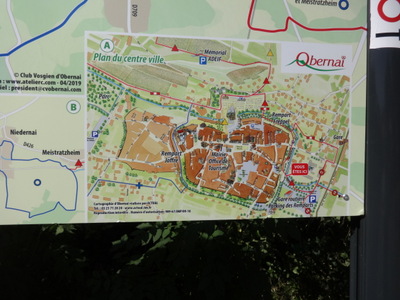
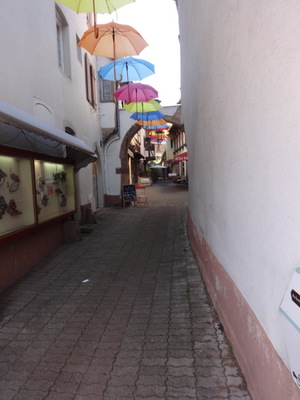 Of course, it was Sunday afternoon, so everything was closed except the bakery and one café, and it was still blazing hot, but we strolled around in the shade of the arcades along the shopping streets. At the right is a handy map of the town that we passed as we entered through, of course, an arched gate in the old city wall (this one strictly pedestrian). The gate is indicated by the red "vous êtes ici" marker, and we just continued up that curving street to the market square, shaded in pale yellow. The actual market has long since outgrown that space and now takes place outside the walls near the big blue "P" for parking.
Of course, it was Sunday afternoon, so everything was closed except the bakery and one café, and it was still blazing hot, but we strolled around in the shade of the arcades along the shopping streets. At the right is a handy map of the town that we passed as we entered through, of course, an arched gate in the old city wall (this one strictly pedestrian). The gate is indicated by the red "vous êtes ici" marker, and we just continued up that curving street to the market square, shaded in pale yellow. The actual market has long since outgrown that space and now takes place outside the walls near the big blue "P" for parking.
At the right is a view up one of the shopping alleys that branched off the market square, gaily decorated with suspended umbrellas. On the square, we admired the orange town hall and the white grain silo, and I photographed some recipe postcards giving recipes for classic Alsatian dishes: bäckeöfe and "choucroute garnis."
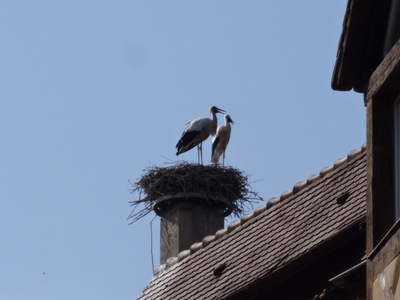
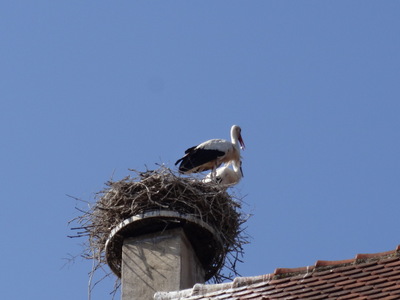 Best of all, though, was that we finally got a good look at storks. A pair was nesting atop an old chimney right on the market square, clacking their beaks, as storks are wont to do.
Best of all, though, was that we finally got a good look at storks. A pair was nesting atop an old chimney right on the market square, clacking their beaks, as storks are wont to do.
At the newly appointed time, though, we piled back onto the bus to continue our scenic route toward our delayed rendezvous.
As it turned out, we had it easy. The ship had much more trouble contacting the guides waiting to conduct those who elected to spend the afternoon in Strasbourg to their buses. They were local folks and not Viking employees. I'm not sure what they did with their extra hour—stayed in Strasbourg, rode around in the bus, or what.
Anyway, when we arrived at the village of Schönau, which was on our left, back from the river, we turned right, on a little dirt tract that widened out after a couple of hundred yards into a small dirt parking lot in the woods. The other bus was already there—I hope they didn't spend the whole extra hour sitting there waiting.
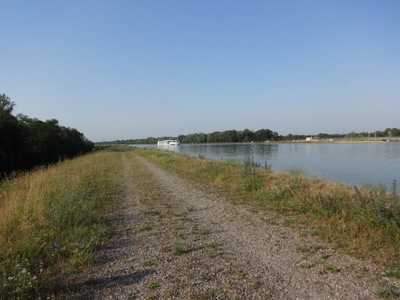
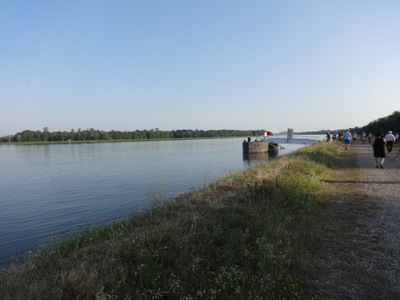 While we waited in the air-conditioned bus, Devin continued along the dirt track toward the river, crossed a little footbridge over a water-filled swale, then climbed a footpath up the side of a tall levee to see whether the ship had arrived. It hadn't, so we waited a while longer in the bus. Finally, word came that the ship was in sight, so we all trooped over and up to the top of the levee, which was deserted except for strolling Viking passengers and a few picknicking locals.
While we waited in the air-conditioned bus, Devin continued along the dirt track toward the river, crossed a little footbridge over a water-filled swale, then climbed a footpath up the side of a tall levee to see whether the ship had arrived. It hadn't, so we waited a while longer in the bus. Finally, word came that the ship was in sight, so we all trooped over and up to the top of the levee, which was deserted except for strolling Viking passengers and a few picknicking locals.
At the left is the view upstream. As you can see, there's nothing in that direction except the isolated landing stage, awaiting the ship. At the right is the view downstream, with the Kvasir finally in sight. Directly across the river were a couple of what looked like grain elevators, but there was absolutely nothing else there. I don't know whether the village uses the landing stage as well or whether Viking just built it for their own use.
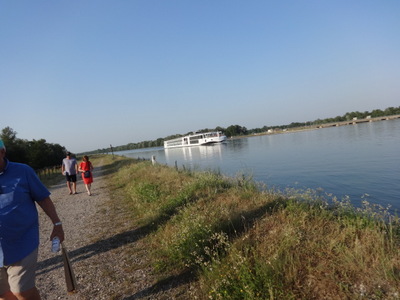
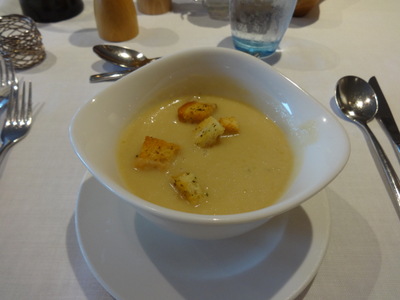 Here, the ship has gotten closer. We waited while it tied up, trooped aboard, and wto our staterooms to drop off our stuff and wash up. Meanwhile, the ship's staff was holding heated discussions on what to do about the dinner schedule, because we were so late. Finally, they decided we should all go directly to the dining room for dinner, and the captain's fairwell toast was conducted there rather than in the lounge as it was supposed to be.
Here, the ship has gotten closer. We waited while it tied up, trooped aboard, and wto our staterooms to drop off our stuff and wash up. Meanwhile, the ship's staff was holding heated discussions on what to do about the dinner schedule, because we were so late. Finally, they decided we should all go directly to the dining room for dinner, and the captain's fairwell toast was conducted there rather than in the lounge as it was supposed to be.
The regional specialties were schweizer wurstsalat (marinated cucumbers Emmental cheese, and ham salad), wiener schnitzel (breaded Viennese veal) with potato salad, and apple crumble pie with vanilla ice cream. The regular menu started with schwarzwurzelsuppe mit kräutercroutons (creamy salsify soup with herb croutons) and farmer's pecorino market salad. The main courses were herb-crusted ahi tuna steak, medium rare, with wilted spinach, boiled potato, and sherry shallot vinaigrette and (for the vegetarians) Thai green vegetable curry. For dessert, carrot cake with cream cheese frosting.
I started with the salsify soup (right), which was good. Salsify is sometimes called "oyster plant" because it's supposed to taste like oysters, but the soup didn't.

 David ordered the schnitzel, which he declared very good.
David ordered the schnitzel, which he declared very good.
The tuna sounded good, but I had long had my eye on the "always available" ribeye, and this was our last night aboard, so I ordered that instead. It came with fries, a vegetable medley, and herb butter. It was excellent. I think I had the carrot cake for dessert, but it wasn't memorable enough to photograph. And really? Carrot cake? Another thing I did not fly to Europe to eat.
Previous entry
List of Entries
Next entry

 The previous day's poached egg had been so good that I ordered them again and ate both. Along with some other stuff, as shown at the right: watermelon, several cheeses, salami, bacon, grilled eggplant, and half a bagel. The apricot wasn't ripe, so I took it back to my stateroom to soften up.
The previous day's poached egg had been so good that I ordered them again and ate both. Along with some other stuff, as shown at the right: watermelon, several cheeses, salami, bacon, grilled eggplant, and half a bagel. The apricot wasn't ripe, so I took it back to my stateroom to soften up.
 We took the scenic route into town, past, among other things the lovely new Russian Orthodox church, consecrated only a month ago. So many Russians and others of Russian Orthodox faith are living in Strasbourg, because of EU business, that renting space for services was no longer an option.
We took the scenic route into town, past, among other things the lovely new Russian Orthodox church, consecrated only a month ago. So many Russians and others of Russian Orthodox faith are living in Strasbourg, because of EU business, that renting space for services was no longer an option.
 At the left here is (I think) the other side of the Court of Justice, although we drove around among many imposing glass and steel buildings with rows of flags out front (the court, the EU Parliament, the Council of Europe, parts of the university), so it was hard to keep track of which buildings I was getting photos of. One of the buildings (Council of Europe, maybe) was described as fortress-like on the outside but soft and comfy inside, to show that Europe is strong against enemies but cushy inside.
At the left here is (I think) the other side of the Court of Justice, although we drove around among many imposing glass and steel buildings with rows of flags out front (the court, the EU Parliament, the Council of Europe, parts of the university), so it was hard to keep track of which buildings I was getting photos of. One of the buildings (Council of Europe, maybe) was described as fortress-like on the outside but soft and comfy inside, to show that Europe is strong against enemies but cushy inside.
 At the end of our scenic bus tour, we were dropped off near the cathedral. Walking toward it, we passed through one little street of shops that was practically lined with simple wooden planters—essentially roughsawn wooden rectangles, maybe a foot square in cross section and 1–2 feet long, that people had stacked in a variety of configurations, filled with dirt, and planted stuff in. Nice.
At the end of our scenic bus tour, we were dropped off near the cathedral. Walking toward it, we passed through one little street of shops that was practically lined with simple wooden planters—essentially roughsawn wooden rectangles, maybe a foot square in cross section and 1–2 feet long, that people had stacked in a variety of configurations, filled with dirt, and planted stuff in. Nice.
 Near the spot where the guide stood to show us the cathedral, on the wall of a nearby museum, is the plaque shown here at the left. The writing, in all caps, has no spaces between the words, no punctuation, and no accents, and the words wrap to the next line any old where, without hyphens, so it took me a minute to puzzle it out, but it says, "A Johann Knauth sauveur de la cathédrale la Ville de Strasbourg reconnaissante 2014"—"to Johann Knauth savior of the cathedral the grateful city of Strasbourg 2014."
Near the spot where the guide stood to show us the cathedral, on the wall of a nearby museum, is the plaque shown here at the left. The writing, in all caps, has no spaces between the words, no punctuation, and no accents, and the words wrap to the next line any old where, without hyphens, so it took me a minute to puzzle it out, but it says, "A Johann Knauth sauveur de la cathédrale la Ville de Strasbourg reconnaissante 2014"—"to Johann Knauth savior of the cathedral the grateful city of Strasbourg 2014."
 At the left here is a better view of the 1830 statue of Gutenberg you can see near the carousel (by our old friend David d'Angers). He lived in Strasbourg for 10 years at one point and first experimented with moveable type there, so the city feels entitled to claim him partially.
At the left here is a better view of the 1830 statue of Gutenberg you can see near the carousel (by our old friend David d'Angers). He lived in Strasbourg for 10 years at one point and first experimented with moveable type there, so the city feels entitled to claim him partially.
 The view at the left is of a particularly quaint little section of town called "La Petite France" ("Little France"). The river Ill, which flows through town, splits at this point, so that the houses at the left in the photo are actually on a island in mid stream. I'd always wondered why "Little France"; aren't quaint sections dense with canals usually called "Little Venice"? The guide explained that it used to be the location of a hospital (now defunct) for syphilis patients. Strasbourg was in Germany at the time, and the Germans called syphilis "the French disease," because they regarded it as having been introduced into the region by French troops. (Of course, at that period, the French called it "the Italian disease," because they thought it had been introduced into France in the 16th century, when France was at war with Italy.
The view at the left is of a particularly quaint little section of town called "La Petite France" ("Little France"). The river Ill, which flows through town, splits at this point, so that the houses at the left in the photo are actually on a island in mid stream. I'd always wondered why "Little France"; aren't quaint sections dense with canals usually called "Little Venice"? The guide explained that it used to be the location of a hospital (now defunct) for syphilis patients. Strasbourg was in Germany at the time, and the Germans called syphilis "the French disease," because they regarded it as having been introduced into the region by French troops. (Of course, at that period, the French called it "the Italian disease," because they thought it had been introduced into France in the 16th century, when France was at war with Italy.
 During the tour, we passed a building with this wonderful mosaic sidewalk out front. It didn't seem to match the building's current use, but it must have meant something originally.
During the tour, we passed a building with this wonderful mosaic sidewalk out front. It didn't seem to match the building's current use, but it must have meant something originally.
 For lunch, I started with the salad and pasta bar. On the salad bar I found slices of bread spread with herbed white cheese and topped with slices of cold beef and crispy onions (very good), a sort of Waldorf of slivered apple and raisins, and a strange "wurstsalat" that I didn't think was very good (picture cold hot dogs cut up and tossed with a creamy salad dressing). The pasta of the day was white clam, complete with whole clams in the shell. At the top left, you can see David's plate—he had the pressed Cuban sandwich with fries.
For lunch, I started with the salad and pasta bar. On the salad bar I found slices of bread spread with herbed white cheese and topped with slices of cold beef and crispy onions (very good), a sort of Waldorf of slivered apple and raisins, and a strange "wurstsalat" that I didn't think was very good (picture cold hot dogs cut up and tossed with a creamy salad dressing). The pasta of the day was white clam, complete with whole clams in the shell. At the top left, you can see David's plate—he had the pressed Cuban sandwich with fries.
 On the way out of town for our tour and wine tasting, we passed this cool bridge. As we first approached, it looked like a typical sort of suspension bridge, supported by an arch. As we passed, though, I could see that it was way cooler than that! The arch was set at an angle to the bridge, so both span the water, but not along the same line. Nice!
On the way out of town for our tour and wine tasting, we passed this cool bridge. As we first approached, it looked like a typical sort of suspension bridge, supported by an arch. As we passed, though, I could see that it was way cooler than that! The arch was set at an angle to the bridge, so both span the water, but not along the same line. Nice!
 Our destination was the village of Mittlebergheim, which was recently voted the second-most-beautiful village in France (after a place in Normandy, or maybe it was Burgundy). On the way we passed through a number of other villages of differing degrees of picturesquitude.
Our destination was the village of Mittlebergheim, which was recently voted the second-most-beautiful village in France (after a place in Normandy, or maybe it was Burgundy). On the way we passed through a number of other villages of differing degrees of picturesquitude.
 In Mittelbergheim, our wine tasting was at the winery of Albert Selz, which had a beautiful courtyard full of potted plants, all different, from junipers to citrus to honeysuckle. Overhead, the light fixtures were in the shape of bunches of grapes.
In Mittelbergheim, our wine tasting was at the winery of Albert Selz, which had a beautiful courtyard full of potted plants, all different, from junipers to citrus to honeysuckle. Overhead, the light fixtures were in the shape of bunches of grapes.
 Of course, it was Sunday afternoon, so everything was closed except the bakery and one café, and it was still blazing hot, but we strolled around in the shade of the arcades along the shopping streets. At the right is a handy map of the town that we passed as we entered through, of course, an arched gate in the old city wall (this one strictly pedestrian). The gate is indicated by the red "vous êtes ici" marker, and we just continued up that curving street to the market square, shaded in pale yellow. The actual market has long since outgrown that space and now takes place outside the walls near the big blue "P" for parking.
Of course, it was Sunday afternoon, so everything was closed except the bakery and one café, and it was still blazing hot, but we strolled around in the shade of the arcades along the shopping streets. At the right is a handy map of the town that we passed as we entered through, of course, an arched gate in the old city wall (this one strictly pedestrian). The gate is indicated by the red "vous êtes ici" marker, and we just continued up that curving street to the market square, shaded in pale yellow. The actual market has long since outgrown that space and now takes place outside the walls near the big blue "P" for parking.
 Best of all, though, was that we finally got a good look at storks. A pair was nesting atop an old chimney right on the market square, clacking their beaks, as storks are wont to do.
Best of all, though, was that we finally got a good look at storks. A pair was nesting atop an old chimney right on the market square, clacking their beaks, as storks are wont to do.
 While we waited in the air-conditioned bus, Devin continued along the dirt track toward the river, crossed a little footbridge over a water-filled swale, then climbed a footpath up the side of a tall levee to see whether the ship had arrived. It hadn't, so we waited a while longer in the bus. Finally, word came that the ship was in sight, so we all trooped over and up to the top of the levee, which was deserted except for strolling Viking passengers and a few picknicking locals.
While we waited in the air-conditioned bus, Devin continued along the dirt track toward the river, crossed a little footbridge over a water-filled swale, then climbed a footpath up the side of a tall levee to see whether the ship had arrived. It hadn't, so we waited a while longer in the bus. Finally, word came that the ship was in sight, so we all trooped over and up to the top of the levee, which was deserted except for strolling Viking passengers and a few picknicking locals.
 Here, the ship has gotten closer. We waited while it tied up, trooped aboard, and wto our staterooms to drop off our stuff and wash up. Meanwhile, the ship's staff was holding heated discussions on what to do about the dinner schedule, because we were so late. Finally, they decided we should all go directly to the dining room for dinner, and the captain's fairwell toast was conducted there rather than in the lounge as it was supposed to be.
Here, the ship has gotten closer. We waited while it tied up, trooped aboard, and wto our staterooms to drop off our stuff and wash up. Meanwhile, the ship's staff was holding heated discussions on what to do about the dinner schedule, because we were so late. Finally, they decided we should all go directly to the dining room for dinner, and the captain's fairwell toast was conducted there rather than in the lounge as it was supposed to be.
 David ordered the schnitzel, which he declared very good.
David ordered the schnitzel, which he declared very good.